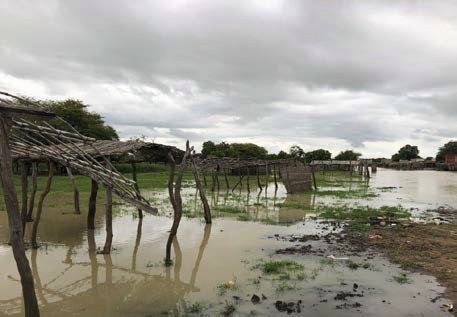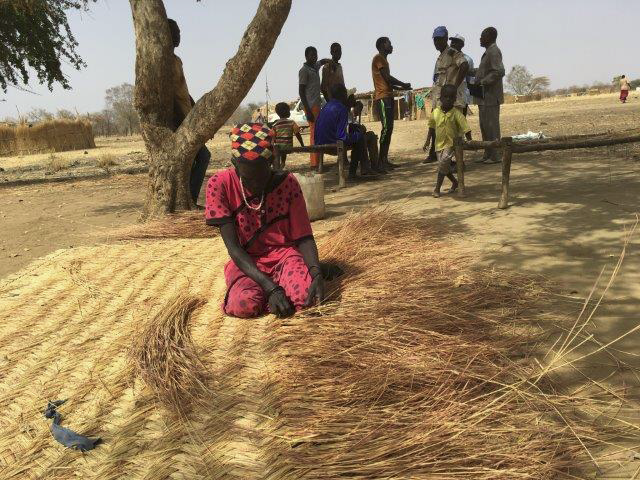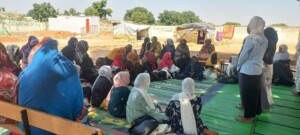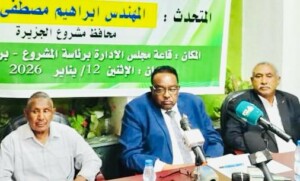Sudan OCHA bulletin 18: Over 200,000 people across Sudan affected by heavy rains and flash floods
Over 200,000 people in 15 of Sudan’s 18 states have been affected by heavy rains and flash floods between June and early November, according to the Government’s Humanitarian Aid Commission (HAC). This is almost double the 122,500 people affected by floods the same time last year. The worst affected states are Kassala (47,500 people), Sennar (33,800 people) and West Kordofan (33,200 people).

Over 200,000 people in 15 of Sudan’s 18 states have been affected by heavy rains and flash floods between June and early November, according to the Government’s Humanitarian Aid Commission (HAC). This is almost double the 122,500 people affected by floods the same time last year. The worst affected states are Kassala (47,500 people), Sennar (33,800 people) and West Kordofan (33,200 people).
According to the latest bulletin of the UN Office for the Coordination of Humanitarian Affairs (OCHA) in Sudan, over 19,640 homes were destroyed, according to the Government of Sudan and partners. Aid organizations continue to respond with food, emergency shelter and household supplies, and provide health, nutrition, water, sanitation and hygiene services to affected people.
Government authorities had required each state to stockpile a sufficient quantity of emergency supplies for 2,000 people. In addition, vital medicines and medical supplies for more than a million people have been made available as part the Government of Sudan and partners national emergency preparedness plan for the rainy season.

Heavy rains and flash floods destroy many structures in Um Dukhun, Central Darfur (UN, Sept 2018)
Red Sea State affected by heavy rains and flash floods
Red Sea is the latest state to witness heavy rains and flash floods, with over 19,000 people in four localities (Port Sudan, Hyia, Tokar, and Dordeeb) affected between October and November, according to HAC.
In Port Sudan locality, 90 homes were destroyed and another 507 damaged, affecting about 3,000 people. In addition, 586 latrines collapsed, and six shops sustained damage.
In Hiya locality, 56 homes were destroyed and 163 houses damaged affecting about 1,000 people.
In Tokar locality, 751 homes were destroyed and 2,253 damaged affecting about 15,000 people. In addition, 70 water sources were contaminated by flood-waters.
In Dordeeb locality, 30 shops were damaged and 50 heads of livestock were died.
The people affected by floods are in urgent need of emergency shelter and household supplies as well as water, sanitation and hygiene assistance, according to HAC.
West Darfur State implements measures reducing farm-related incidents this year
There has been a decline in the number of farm-related incidents in West Darfur—including land disputes and crop destruction—following new measures introduced by the West Darfur State government, according to reports from the United Nations – African Union Mission in Darfur (Unamid).
Since the beginning of the rainy season in June 2018, the number of farm related incidents has reduced significantly. 27 incidents were reported in June, which dropped to 16 in July; eight in August; six in September; and nine in October. October marks the beginning of the harvest season when farm destruction incidents are usually high.
The new measures include setting 15 January as the date for animal release—which is after the harvest; the provision of veterinary services in the northern part of the state to help keep pastoralists and their animals in that area until 15 January; and the construction of Hafeers (dams) in different areas to ensure both farmers and pastoralists have enough water. These new measures in addition to the security measures the state government has previously imposed (weapons collection; the ban on carrying weapons; the ban on using motor-bikes; and the ban on wearing the traditional face mask) have also contributed to reducing these incidents.
ICRC provides food and household items to over 3,300 returnee families in North Darfur
Upon their return to their home areas in Tawila locality, North Darfur State, many returnees—some of whom have been displaced for over a decade—found their villages largely destroyed and homes broken down. Their living conditions were dire, compounded by an acute shortage of food, water, and essential household supplies.
70-year-old Mohamed Adam is one of the returnees to Tawila. He and this family had fled to Zamzam camp, located 15 km south of the state capital, El Fasher town. They lived in the camp for 10 years until the middle of June of this year, when they decided to voluntarily return to their home village due to the improved security situation.
In response to the needs of the returnees, the International Committee of the Red Cross (ICRC) and the Sudanese Red Crescent Society (SRCS) provided Mohamed Adam and other returnees with food and household supplies. About 3,300 families (16,500 people) from the villages of Mertal, Khazan Tunjur and Dubbo El Omda received food assistance, while 660 families received essential household supplies. In addition, the ICRC repaired 19 water hand pumps restoring clean water access to 9,500 people.
It took Mohamed Adam one hour and thirty minutes by donkey to arrive at the distribution centre. Despite his frail look, he managed to make the trip alone, as his two teenage sons had to urgently go to his farm to secure it from prowling cattle that could eat up crops that were awaiting harvest. His wife is unable to walk, having sustained a serious gunshot wound 10 years ago when fighting broke out near their village.
The ICRC also aims to establish mid-term and long-term projects to improve the economic and livelihood status of the community.
Abyei Area: Humanitarian and recovery needs remain significant
Humanitarian and recovery needs remain significant in the Abyei Area, states the United Nations Secretary-General report on the situation in Abyei issued in mid-October 2018. In 2018 the Abyei Area faced small-scale emergencies, including spikes in malnutrition and flooding that resulted in new displacements. Currently, some 2,000 people have been affected by floods in the area.

A South Sudanese woman living with the Misseriya community in Diffra (northern Abyei Area) making mats to sell (OCHA, 2018)
Humanitarian organizations are assisting some 182,000 vulnerable people across the Abyei Area, including: 87,000 people from the Ngok Dinka communities and returnees; 15,000 Ngok Dinka displaced within the Abyei Area; 9,000 people displaced from neighbouring states in South Sudan; 34,000 people from the Misseriya communities; and 37,000 seasonal Misseriya migrants who had entered the area in October 2018 and will migrate back to West Kordofan between June and July 2019. In addition, people transitioning through the Abyei Area from South Sudan have been assisted with non-food supplies.
The aid community assists vulnerable people throughout the Abyei Area. However, the absence of formal authorities continues to pose a challenge in carrying out and coordinating humanitarian and recovery interventions. To protect the most vulnerable people and support the rule of law, the existing detention facility in Abyei town has been rehabilitated.
While the aid community working in the area has limited capacity, community expectations are high, according to aid organizations on the ground. Lack of development projects and the inability to deliver basic social services continues to have an adverse effect on people in the Abyei Area. To enhance community engagement and build local support, the United Nations Interim Security Force for Abyei (UNISFA) facilitated the delivery of humanitarian assistance by providing logistical support, especially during the rainy season. Starting in August, UNISFA arranged special flights and escort services for humanitarian partners to carry out humanitarian assessments and address the increasing number of malaria cases being reported.
The Government, WHO and UNICEF renew their commitment to keep Sudan polio-free
The Government of Sudan, the World Health Organization (WHO), the UN Children’s Agency (UNICEF) and partners renewed their commitment to keep Sudan polio-free while celebrating World Polio Day on 24 October 2018.
Sudan has not reported any polio cases since March 2009 and was announced polio-free in 2015 by WHO.
Over 90 per cent of children targeted annually were consistently reached with Polio vaccines, thanks to the strong collaboration between the national health authorities and partners with the generous support from donors. Despite this, the country is still considered at risk of the wild polio virus due to population movements.
“Keeping Sudan polio free has been a top priority for the Government in Sudan and a key factor for the implementation of overall health security,” said Dr Mohamed Abuzeid, the Federal Minister of Health.
WHO, UNICEF and non-governmental health partners in Sudan will continue to support the Federal Ministry of Health to maintain sensitivity of surveillance and increase vaccination coverage to sustain the polio-free status and protect children against this crippling and fatal infectious disease.
Germany quadruples its support to the Sudan Humanitarian Fund
In its latest support to the people of Sudan, the Federal Republic of Germany has contributed US$4.6 million towards the Sudan Humanitarian Fund (SHF), about four times its usual donation. To date, the SHF has received a total of $44 million in donor contributions for 2018, enabling humanitarian partners to assist people in need through comprehensive, complementary, and area-based interventions.
This year the SHF and partners are targeting Jebel Marra and certain localities in North Darfur, Blue Nile, South Kordofan, and Kassala states as areas with significant humanitarian needs. Multi-year funding was allocated to address humanitarian needs resulting from malnutrition, protracted displacement and returnees.
The SHF responds to unexpected emergencies through its reserve allocations and prioritizes humanitarian needs within the Sudan Multi-Year Humanitarian Strategy and the Humanitarian Response Plan (HRP) through its standard allocations. SHF allocations are inclusive, flexible, timely, efficient, and accountable to maximise strategic impact and support best-positioned responders to alleviate the most urgent humanitarian needs. For more information on the SHF, please visit their webpage at the following link.











 and then
and then